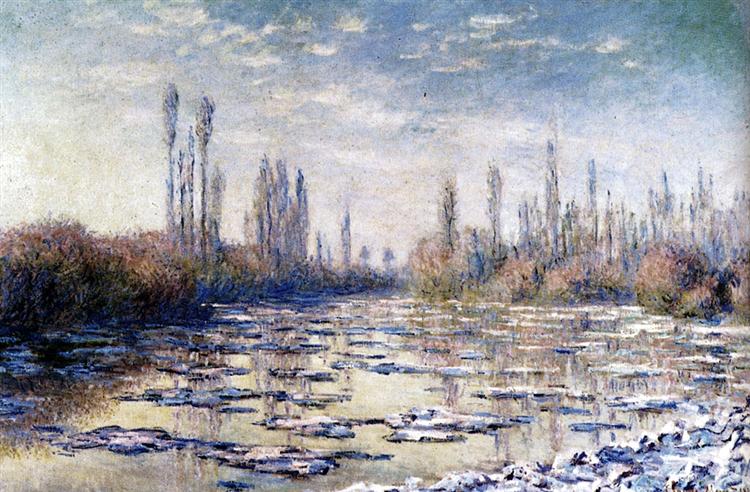Popis
Claude Monet's "Floating Ice near Vetheuil" (1880) is a captivating reflection of the artist's mastery of Impressionism and his unique connection to the landscape that surrounded him. Part of a series of works dedicated to the depiction of the seasons and seasonal changes, this painting captures an ephemeral moment on the banks of the Seine, where fragments of floating ice become protagonists of a visual dialogue between the water and the surrounding atmosphere.
The composition is articulated with a subtle asymmetry that invites the viewer to immerse themselves in the scene. The calm but present river flows in the foreground, while the scattered and fragmented ice sheets lend a sense of dynamism. Monet uses an almost abstract approach to depicting the ice; his light, choppy treatment of the painting’s surface allows the viewer’s eyes to glide over the work, creating the illusion of movement and fluidity in the water. The shadows cast by the ice pieces on the water are instrumental in giving depth and nuance to the river’s surface, revealing Monet’s ability to understand and depict the interplay of light in the natural environment.
The use of color in this work is equally notable. Monet establishes a palette dominated by cool tones—blues, grays, and whites—that evoke winter serenity. However, he also incorporates touches of warmth through subtle reflections that bring the scene to life; flashes of pale yellow and orange find their way among the shadows and ice, suggesting the autumn sunlight that is beginning to fade. This chromatic duality enhances the atmosphere of the painting, infusing a sense of melancholic calm that characterizes many of Monet’s works.
In the background of the composition can be seen the landscape of Vetheuil, a small village that was a constant source of inspiration for the artist. Although the human figures are few and barely discernible, the presence of the small group on the shore adds an element of life and scale to the painting, underlining the intimate relationship between humans and the natural environment. This almost ethereal approach to the inclusion of human figures is characteristic of Monet; he often prefers to place the emphasis on the setting rather than on explicit narrative.
"Floating Ice near Vetheuil" not only illustrates Monet's technical skill in the treatment of light and color, but also his commitment to reflecting on the fleeting experiences of nature. This work embodies Impressionism's quest to capture the ephemeral and the tangible, where the precise moment of observation becomes the essence of art. Monet, through his technique, achieves an immortalization of emotion over that which is temporary, creating an atmosphere that resonates deeply with the viewer.
In the broader historical context, “Floating Ice near Vetheuil” is a testament to the turn that art took towards modernity at the end of the 19th century. Monet, along with other contemporaries, moved away from the idealized and academic representation of nature, seeking instead an authentic connection with the world around him. This work is therefore not only a representation of the beauty of the landscape, but also a milestone in the evolution of modern art, a point of departure towards new ways of seeing and understanding the natural environment.
KUADROS ©, a famous painting on your wall.
Hand-made oil painting reproductions, with the quality of professional artists and the distinctive seal of KUADROS ©.
Painting reproduction service with satisfaction guarantee. If you are not completely satisfied with the replica of your painting, we will refund 100% of your money.

